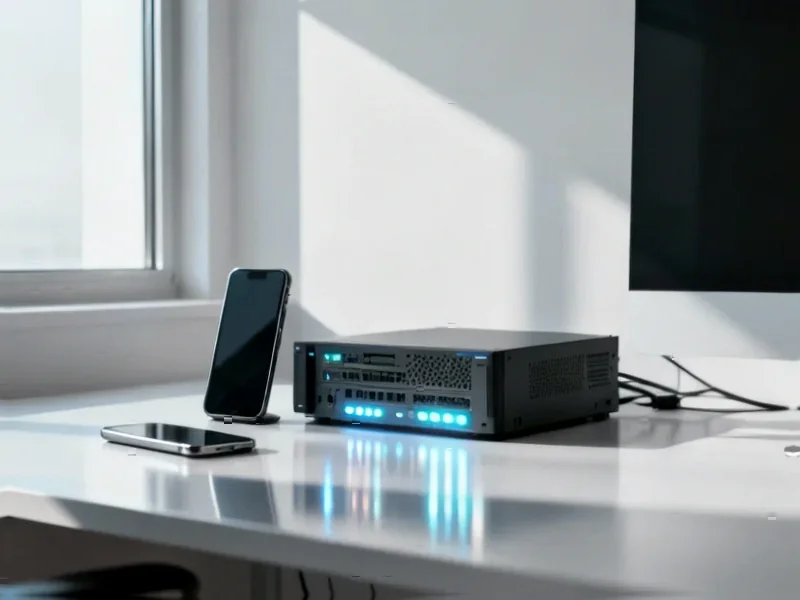According to PYMNTS.com, Apple reported $102.5 billion in September-quarter revenue with iPhone revenue hitting a record $49 billion, up 6% year-over-year. CEO Tim Cook revealed that Apple is “significantly increasing investments in AI” and disclosed the company has begun manufacturing servers for Apple Intelligence in Houston with plans to release a more personalized Siri next year. Services revenue reached an all-time high of $28.8 billion, up 15%, pushing total fiscal-year services revenue past $100 billion. Despite these gains, Apple faced a 4% revenue decline in Greater China driven by iPhone weakness, though Cook expects a return to growth this quarter. The company also flagged rising tariff costs increasing from $1.1 billion to $1.4 billion quarter-over-quarter.
Table of Contents
The $100 Billion Services Milestone
Apple crossing the $100 billion annual services revenue threshold represents a fundamental transformation of the company’s business model. While Apple built its reputation on hardware excellence, services now provide the stable, recurring revenue that investors crave. The 15% growth in services revenue dramatically outpaces the company’s overall growth rate, suggesting that Apple’s ecosystem strategy is paying dividends. This services revenue includes everything from App Store commissions to Apple Pay transactions and advertising, creating multiple revenue streams that are less dependent on the volatile hardware upgrade cycle. The double-digit growth in Apple Pay users indicates the company is successfully expanding beyond its traditional strengths into financial services.
The AI Infrastructure Gamble
What’s particularly revealing in these earnings is Apple’s quiet but massive investment in AI infrastructure. The disclosure that Apple is manufacturing its own servers in Houston for Private Cloud Compute represents a strategic shift toward vertical integration that mirrors their approach to chip design. By controlling both the hardware and software stack for AI, Apple aims to deliver the privacy-focused differentiation that has become central to their brand identity. However, this infrastructure buildout comes with significant capital expenditure that will pressure margins in the near term. The company’s willingness to absorb these costs while maintaining 47-48% gross margin guidance shows confidence in their ability to monetize AI capabilities long-term.
Siri Reboot and Competitive Landscape
The promised “more personalized Siri” for 2025 represents Apple’s attempt to close the gap with competitors who have raced ahead in AI assistants. Under Tim Cook’s leadership, Apple has traditionally moved deliberately rather than first to market, but the AI revolution has accelerated competitive pressures. The admission that Apple is “open to pursuing M&A” where it advances their AI roadmap suggests recognition that internal development alone may not be sufficient. The rumored interest in companies like Perplexity indicates Apple may be looking to acquire advanced AI capabilities rather than build everything from scratch. This represents a significant shift from Apple’s historical preference for organic development.
China Challenges and Global Strategy
The 4% decline in Greater China revenue reveals Apple’s vulnerability in what was once their most promising growth market. While Cook attributed the decline to supply constraints, the reality is more complex. Chinese consumers are increasingly opting for domestic smartphone brands that offer comparable features at lower price points, particularly as Huawei makes a comeback. The geopolitical tensions between the U.S. and China create additional headwinds for Apple’s operations in the region. However, Apple’s global diversification provides some insulation – strong performance in other markets helped offset the China weakness, demonstrating the resilience of their worldwide distribution network.
Investment Implications and Outlook
Apple’s increasing capital expenditures for AI infrastructure signal a new phase of investment that will likely pressure near-term profitability. The company is betting that Siri’s transformation and broader AI capabilities will drive the next generation of hardware upgrades and service adoption. However, the timeline for meaningful AI revenue contribution remains uncertain, creating execution risk. The rising tariff costs also highlight Apple’s supply chain vulnerability at a time of increasing trade tensions. Investors should watch for whether Apple can maintain its premium pricing power while absorbing these increased costs, particularly in competitive markets like China where local alternatives are gaining traction.



